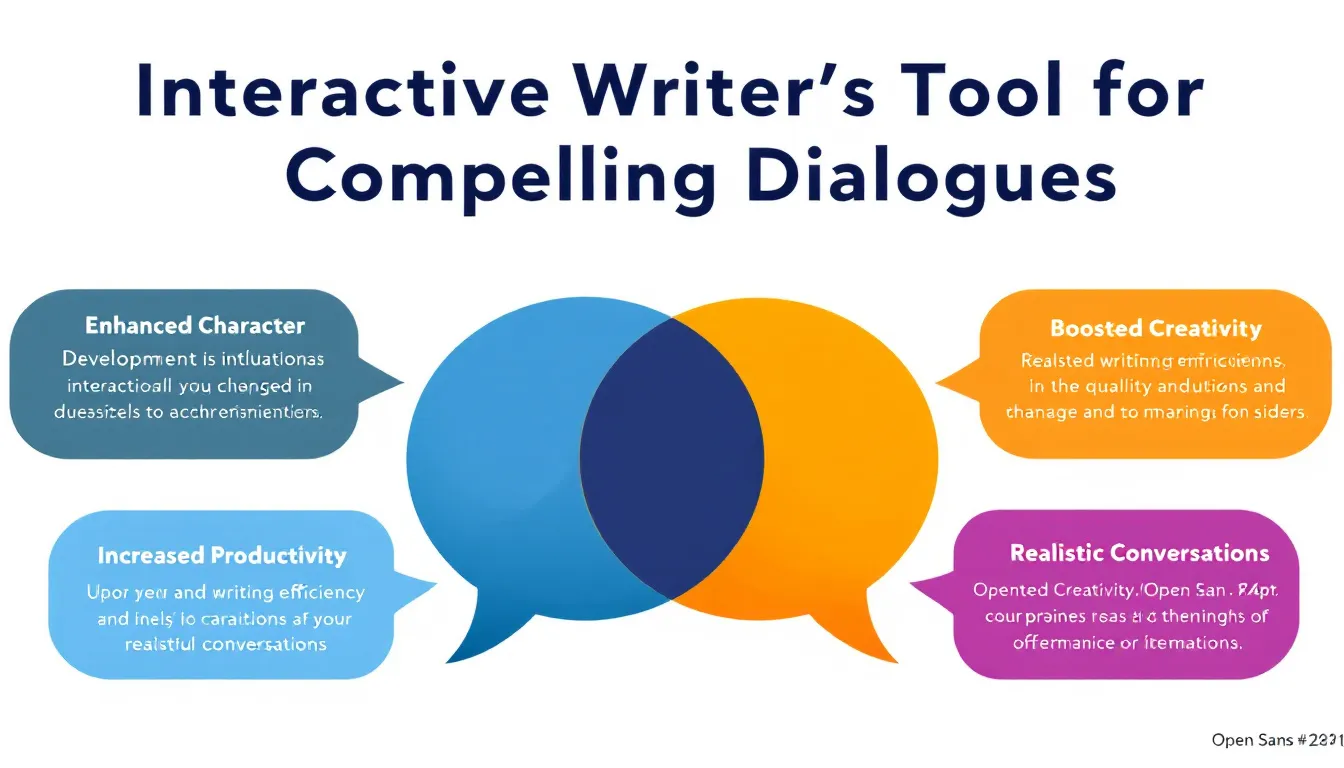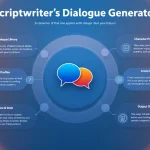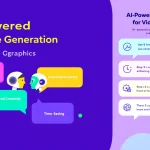Is this tool helpful?
How to Use the Dialogue Generator Tool Effectively
This Dialogue Generator Tool helps you craft natural, compelling conversations between characters quickly. To get the best results, follow these easy steps:
-
Enter Character Details: In the “Characters” field, write brief descriptions of each character involved. Include their names and key traits that shape their speech and attitude. For example:
- Alice: A pragmatic lawyer in her mid-30s who values logic over emotion.
- Ben: A passionate environmental activist in his early 20s, idealistic and outspoken.
-
Define the Dialogue Topic: In the “Topic” field, state the central theme or situation around which the dialogue revolves. Sample topics could be:
- Negotiating terms for a controversial business merger
- Debating the impact of social media on mental health
- Generate the Dialogue: Click the “Generate Dialogue” button to create a conversation tailored to your characters and topic.
- Review and Edit: Examine the generated dialogue. Use it as a foundation, and adjust it to fit your story’s tone, pace, and direction.
- Copy and Implement: When you’re happy with the dialogue, use the copy function to transfer your text into your writing project.
Introduction to the Dialogue Generator Tool
The Dialogue Generator Tool is a practical writing assistant designed for authors, screenwriters, and storytellers. It helps you create authentic, character-driven conversations by using character descriptions and a central topic to produce rich dialogue scenes.
This tool saves you time by streamlining the dialogue-writing process, ensuring your characters maintain consistent voices and viewpoints. It also sparks creativity when you encounter writer’s block or need fresh ideas for character interactions.
Purpose and Benefits
- Accelerate Writing: Quickly generate dialogue drafts instead of starting from scratch.
- Keep Character Voices Consistent: Reflect each character’s unique personality and background in their speech.
- Boost Creativity: Overcome writer’s block with fresh, character-based interactions.
- Flexible Output: Tailor the generated dialogue to your narrative needs.
- Skill Development: Learn dialogue techniques by studying generated examples.
Practical Applications of the Dialogue Generator Tool
While this tool doesn’t perform calculations, it provides valuable assistance for multiple writing contexts. Here’s how you can apply it in your projects:
1. Novel Writing
Create realistic conversations that develop characters and drive the plot. The tool helps establish tension, reveal motivations, and build relationships naturally.
2. Screenwriting
Draft dialogues for scenes efficiently, maintaining distinct character voices throughout episodes and ensuring emotional consistency.
3. Video Game Writing
Generate branching dialogue options for player interactions, keeping NPC (non-player character) voices consistent across various scenarios.
4. Tabletop Role-Playing Games
Produce in-the-moment NPC dialogue that adapts to your story, enhancing immersion and adding depth to encounters.
5. Playwriting
Explore character dynamics and generate first drafts of key scenes, helping you capture natural speech patterns for ensemble casts and complex personalities.
6. Educational Content Creation
Create engaging, informative dialogues for educational videos or language learning materials, showcasing multiple perspectives on various topics.
Key Advantages of Using This Dialogue Generator
Enhances Character Development
By providing detailed character profiles, you ensure the dialogue reflects each individual’s unique style, background, and motivations. This consistency makes your characters feel authentic and relatable.
Overcoming Writer’s Block
The tool offers you a solid starting point for creating conversations, helping you bypass creative stalls and discover new angles for your scenes.
Saves Time in Writing
Skip the frustration of blank pages. Generate dialogue drafts quickly so you can focus on revision and tailoring instead of drafting every line from scratch.
Explores Different Perspectives
Write dialogues that highlight contrasting viewpoints, enriching your story with tension, drama, and thematic depth. This works well for debate scenes, conflicting motivations, and complex themes.
Maintains Consistency in Tone and Style
Whether you’re writing a long series, collaborating with others, or developing recurring characters, this tool helps keep character voices steady and true to their profile.
Develops Dialogue Skills
Use the generated conversations as models to understand dialogue flow, use of subtext, pacing, and how personality shapes speech patterns.
Solving Common Dialogue Writing Challenges
Creating Distinct Character Voices
- Use precise character details to shape speech patterns and tone.
- Keep voices consistent throughout the dialogue.
- Reflect personality traits clearly in the dialogue content.
For example, imagine a conversation between a strict military officer and a laid-back freelance journalist about cybersecurity:
Officer: “We need rigorous protocols to prevent data breaches, no exceptions.”
Journalist: “Sure, but too much red tape can slow down innovation.”
Officer: “Security takes priority over speed, always.”
Journalist: “I get that, but there’s got to be a balance. Otherwise, we lose agility.”
Incorporating Subtext and Nuance
- Layer conversations with unspoken tensions or hidden motives.
- Balance what characters say with what they avoid mentioning.
- Use dialogue to reveal underlying dynamics gradually.
Example dialogue between two coworkers discussing a promotion:
Jenna: “So, I heard the manager’s position is open.”
Mark: “Yeah. I guess everyone’s got their eyes on it.”
Jenna: “Including you?”
Mark: “Let’s just say I’m waiting for the right moment.”
Behind the words, a rivalry simmers beneath the polite exchange.
Balancing Exposition with Natural Flow
- Embed necessary background information smoothly into dialogue.
- Assign factual exposition to the character who’d naturally provide it.
- Maintain realistic speech patterns while delivering key details.
Example:
Maria: “Did you catch the news about the new environmental regulations?”
James: “No, I’ve been swamped. What’s happening?”
Maria: “They’re tightening emissions limits for factories starting next year.”
James: “That’ll impact my supplier for sure.”
Additional Tips for Getting the Most from This Dialogue Generator
- Be specific with character traits. The more detailed your descriptions, the more tailored the dialogue.
- Choose clear, focused topics. Defining the subject precisely helps create coherent conversations.
- Use the generated dialogue as a draft. Customize and refine it to fit your story’s tone and pacing.
- Experiment with diverse character combinations. This reveals fresh interaction possibilities and dialogue directions.
Conclusion
Use the Dialogue Generator Tool to simplify creating believable character conversations. It ensures distinct voices, injects creativity, and helps you focus on polishing your story. Whether you’re writing a novel, script, game, or educational content, this tool helps make your character dialogues more vibrant, natural, and effective.
Important Disclaimer
The calculations, results, and content provided by our tools are not guaranteed to be accurate, complete, or reliable. Users are responsible for verifying and interpreting the results. Our content and tools may contain errors, biases, or inconsistencies. Do not enter personal data, sensitive information, or personally identifiable information in our web forms or tools. Such data entry violates our terms of service and may result in unauthorized disclosure to third parties. We reserve the right to save inputs and outputs from our tools for the purposes of error debugging, bias identification, and performance improvement. External companies providing AI models used in our tools may also save and process data in accordance with their own policies. By using our tools, you consent to this data collection and processing. We reserve the right to limit the usage of our tools based on current usability factors.







